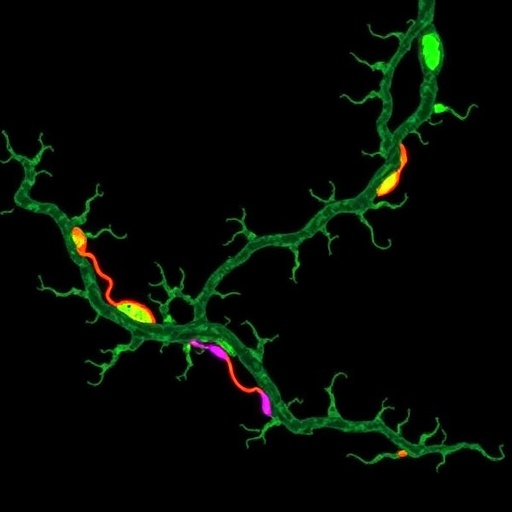In recent years, the field of pediatric medicine has witnessed considerable advancements in the early diagnosis of various congenital conditions. Among these, biliary atresia—a progressive liver disease in infants—remains a significant focus for researchers and healthcare professionals alike. The urgency surrounding early diagnosis is underscored by the correlation between timely intervention and improved outcomes for affected infants. A systematic review and meta-analysis conducted by Li, Deng, and Liao offers new insights into the utility of MMP-7 as a diagnostic biomarker for biliary atresia, potentially reshaping current diagnostic protocols.
Biliary atresia, characterized by the blockage or absence of bile ducts, can lead to severe liver damage and liver failure if not diagnosed and treated promptly. The disease affects newborns and, without surgical intervention such as portoenterostomy, results in cirrhosis and leads to the need for liver transplantation. Early detection is crucial, primarily because the clinical manifestations often mimic other gastrointestinal conditions, leading to diagnostic delays. This backdrop sets the stage for exploring MMP-7 (matrix metalloproteinase-7) as a promising biomarker.
Matrix metalloproteinases, including MMP-7, are enzymes that play pivotal roles in the remodeling of extracellular matrix components, influencing various physiological and pathological processes. In the context of biliary atresia, MMP-7 has garnered attention for its role in liver tissue injury and inflammation. The increasing expression of MMP-7 in liver diseases has prompted researchers to consider its potential as a diagnostic tool. Li and colleagues meticulously evaluated existing studies to ascertain the diagnostic accuracy of MMP-7 in identifying biliary atresia.
The systematic review encompassed multiple clinical studies, synthesizing data on MMP-7 levels in patients diagnosed with biliary atresia compared to healthy infants and those with other liver conditions. By employing rigorous statistical analysis, the authors were able to calculate pooled sensitivity, specificity, and likelihood ratios, thus establishing the validity of MMP-7 as a reliable diagnostic marker. This comprehensive approach not only offers clarity on the sensitivity of MMP-7 but also highlights its specificity and potential utility in clinical practice.
The results of the meta-analysis indicated that MMP-7 possesses a promising diagnostic accuracy, suggesting that elevated levels could serve as a red flag for clinicians when assessing infants who present with jaundice and other symptoms suggestive of biliary atresia. This revelation could prompt a shift in current practices, enabling pediatricians to utilize MMP-7 testing as part of a broader diagnostic workflow, which may include imaging studies and liver function tests.
Additionally, the findings of this systematic review have implications for the development of new diagnostic guidelines. Currently, the standard approach involves a series of invasive tests, including liver biopsy, which can be distressing and carry risks for infants. The integration of MMP-7 testing into the diagnostic pipeline could reduce the need for such invasive procedures, providing a less traumatic experience for both patients and families.
Moreover, the study underscores the necessity for continued research into biomarkers that can enhance diagnostic accuracy in pediatric liver diseases. MMP-7 is just one example of a burgeoning field of investigation where biomarkers may play foundational roles in non-invasive diagnosis and treatment monitoring. As our understanding of biological markers expands, so too does the hope for improved patient outcomes.
As with any emerging diagnostic tool, however, the clinical implementation of MMP-7 testing requires careful validation across diverse populations and clinical settings. The limitation of single-center studies and variability in assay techniques can impact the overall diagnostic performance. Therefore, large, multicenter studies are essential to corroborate the findings of Li, Deng, and Liao, ensuring that the results are generalizable and applicable to broader clinical practice.
Furthermore, the landscape of pediatric liver disease diagnostics is ever-evolving, with innovations in technology and methodology paving the way for more refined approaches. Future studies could explore the synergy of MMP-7 with other biomarkers, enhancing the diagnostic accuracy and offering a multi-faceted view of liver health in infants. Notably, the integration of genomics and proteomics may also yield novel insights into biliary atresia, leading to earlier diagnosis and better management strategies.
In summary, the systematic review by Li and colleagues presents a compelling case for MMP-7 as a valuable player in the diagnostic algorithm for biliary atresia. As the pediatric medical community grapples with the challenges posed by this condition, incorporating MMP-7 testing could ultimately streamline diagnostics and enhance outcomes. Effective communication and collaboration among researchers, clinicians, and regulatory bodies will be crucial to facilitate the implementation of this research into everyday clinical practice, ensuring that affected infants receive timely interventions.
Ultimately, as we continue to decipher the complexities of liver diseases in infants, the insights gained from studies like this serve as a beacon of hope, guiding further exploration and innovation in pediatric medicine. The path forward lies in leveraging scientific discoveries to create actionable strategies that benefit the youngest and most vulnerable members of our society, ensuring they have the best possible start in life.
By fostering an environment of collaboration among researchers and practitioners, and by remaining vigilant to the latest findings, the medical community can hope to continue improving the care and outcomes for infants diagnosed with biliary atresia and other related conditions.
Subject of Research: Biliary Atresia and MMP-7 as a Diagnostic Marker
Article Title: The diagnostic accuracy of MMP-7 for the diagnosis for biliary atresia- a systematic review and meta-analysis.
Article References:
Li, Z., Deng, Y. & Liao, Q. The diagnostic accuracy of MMP-7 for the diagnosis for biliary atresia- a systematic review and meta-analysis.BMC Pediatr 25, 652 (2025). https://doi.org/10.1186/s12887-025-06032-6
Image Credits: AI Generated
DOI: 10.1186/s12887-025-06032-6
Keywords: biliary atresia, MMP-7, pediatric liver disease, biomarkers, diagnosis, meta-analysis




